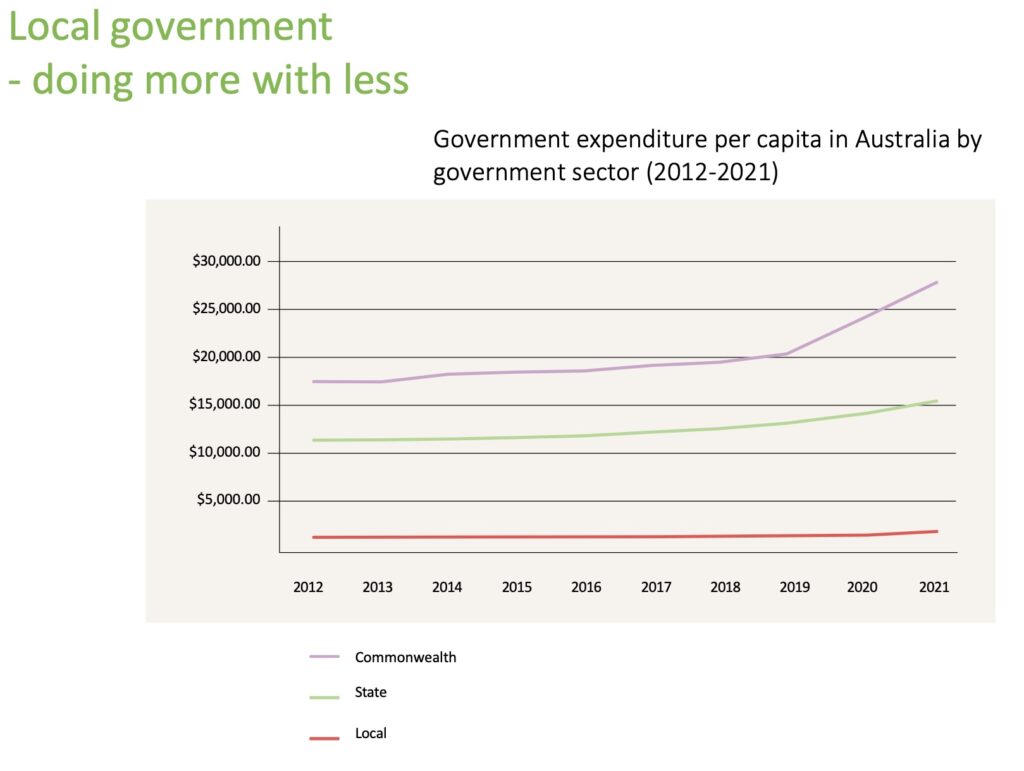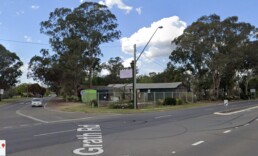Hawkesbury Council
Launch of the "futureofthehawkesbury.com" website
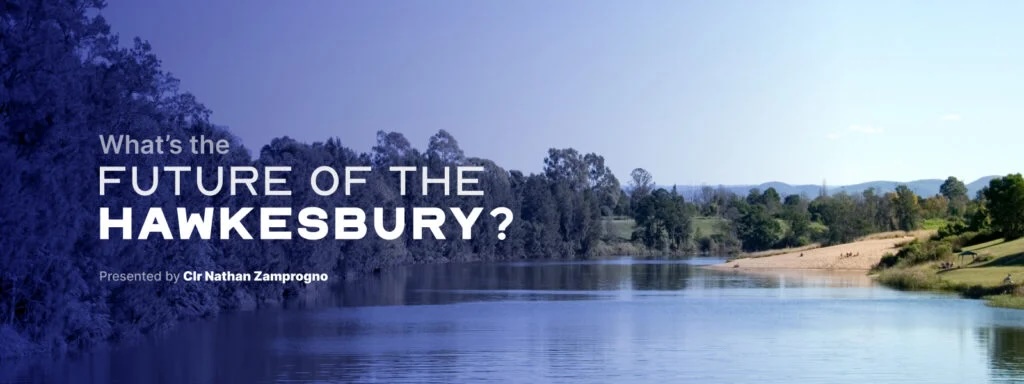 This year is a Council election year.
This year is a Council election year.
The biggest question facing us is this: What do you want the future of the Hawkesbury to be?
We want the Hawkesbury to thrive, with vibrant town centres and well maintained roads. We want to look after our heritage and our environment. But the biggest thing Council will ever take a position on is how many more houses will we build in our city. There are developers who want to build thousands more houses in our city, on both sides of the river.
You shouldn't believe that more urban sprawl can’t be avoided, or that if we share our views, we won't be heard.
So I'm launching "futureofthehawkesbury.com", a new website. Its job is to host surveys and petitions to gather the widest ever spread of your views about roads, development, the environment, child-care and other matters on which Council can make a difference.
In late 2020, Council debated our housing policy. We know the suburbs along the south-eastern boundary of our city (like Oakville, Vineyard and Maraylya) are on the front line of the pressure for more development. Look at what's happening along Windsor Road, and on the eastern side of Boundary Road.
The pressure for yet more areas to be subdivided is splitting our community. I recognised that some are in favour of subdivision, and some against. In that debate I said the simplest and most courteous thing we should do, and especially in those suburbs, is ask everyone what they want the future to look like. I was voted down. More recently, I re-floated the idea of a comprehensive survey asking what people's views on development were, and it was clear I wouldn't have the numbers to pass it in the chamber.
I have my theories. Those against development worry that even asking the question opens a can of worms. Those for development worry that a properly comprehensive survey will prove that a majority of Hawkesbury residents are against it.
But the website is about more than that. If there's an issue you think Council is neglecting, and you want to prove that the community are united in demanding action, sign one of the petitions we're kicking off with, or suggest your own.
This September will be the most consequential Council election in the Hawkesbury's history.
Watch this one-minute introduction, and then head on over to the website. Be engaged, and be heard.
The Australian Local Government Assembly - What Hawkesbury can learn from a bigger picture, especially as it relates to natural disasters
Just before the floods overtook us all, I attended the Australian Local Government Assembly (ALGA) down in Canberra, an annual conference that pulls together the 537 local governments around Australia.
Our focus is the bigger picture of local government as it relates to the nation as a whole – a perspective that I believe my colleagues often misunderstand because they express little interest in the subject. Only Councillor Lyons-Buckett and Councillor Wheeler have been regular attendees with me over the last six years.
Presciently, a lot of what we heard about was about the increasing cost of natural disasters, and the disproportionate burden placed on Councils in the repair and cleanup.
The evidence is clear: Local Governments are the most disadvantaged tier of Government in Australia. Councils directly take in only 3.5% of all taxation revenue levied across all three tiers of government, and yet Local Governments are responsible for 24% of all public assets and service provision, not to mention planning how our communities can grow and thrive. The balance has to come from a patchwork of grants and programs from State and Federal governments which are neither predictable over time, and which have slipped further and further behind costs as the years have passed.
I'm a believer in the principle of subsidiarity – that decisions consequential to how we live are best made by those who are closest to those effected by any policy. So, I am happy to join my voice to my colleagues in calling to other tiers of government to set things right, both as a crucial reform, and as a nation building exercise.
The video above is my report about what I learned – I pushed through a reform to Council which demanded Councillors give an account to you after they are sent to conferences to prove they were paying attention (the Labor and Liberal Councillors have disappointingly since rescinded that accountability measure). And below I give a small selection of further data gained from conference presentations:
The first relevant figure is that the support given to all Local Governments from Federal taxation revenue has about halved over the last 40 years. It used to be about 1% of all Federal Taxation revenue and now sits at about 0.55%. This includes Roads to Recovery funding and Federal Assistance Grants.
The only revenue Councils can levy directly are through Council rates. In NSW this is constrained by the infamous "Rate Peg" - This year Councils were asked to raise rates by only 0.8% when inflation and costs were rising at a rate above 5% p.a. As a share of all taxation revenue raised in Australia, we've slipped badly despite millions of dollars of cost-shifting to Councils.
Meanwhile, government expenditure per capita has ballooned over the last decade, while the Local Government's ability to invest has remained static. We know Council's get a lot of flack for poor service and potholed roads, but in objective terms, we have been squeezed and squeezed and run an increasingly frugal outfit.
This conclusion is backed up by International data which shows that Local Governments in Australia are very poorly resourced compared to other nations. The above graph comes from a New Zealand study (thus the emphasis), but Australia is there, all the way over at the right, and small fraction compared to many other developed nations.
Local government however remains easily the most trusted tier of government in Australia, and especially among young people.
Lastly, I want to turn to what we heard about the increasing costs of natural disasters, especially in the light of what has just struck our community, again, with catastrophic effect.
We received a briefing from Deloitte which shows starkly what we have been through begins to look like when extrapolated to the largest scale.
Natural disasters are costing our economy $38 Billion in each and every year, and those costs are expected to rise to more than double that within 30 years – both as a result of climate change but also if we fail to adapt, mitigate and improve the resilience of our communities to disaster. The Hawkesbury is clearly at the coal face of this challenge. We were told that 97% of all natural disaster funding is spent after disasters have struck, and yet only 3% of funds are spent proactively to mitigate those events (such as raising Warragamba Dam!) or in building resilience into our communities and infrastructure.
Australia stands to realise a $380BN economic dividend resulting from proactive resilience-planning and climate-adaptation initiatives, and potentially create over 73,000 full time jobs (by 2050) if we begin to act now, in sectors as varied as manufacturing, transport, construction, services and the retail sector.
I attended a briefing from the National Recovery and Resilience Agency. Unaware at the time of what was about to visit us, I pleaded with them to address all the deficiencies in disaster preparedness and response we've just seen again.
I said that since 2020, we have had the worst bushfires in history, a pandemic, and multiple floods, the last of which was the worst in 44 years.
In March, 800 houses on our floodplain were flooded, but 25,000 could be at risk in a worse one, and that this is statistically a certainty over time.
I pointed out that the agency has made a $50m pledge in the 2021-22 “National Flood Mitigation Infrastructure Program” to fund 37 different projects around the country, and yet not a single dollar is earmarked for spending in the Hawkesbury-Nepean – the largest unprotected floodplain in the nation.
I told them that after floods in 2020, 2021 and March 2022, the State government had promised landowners fronting our rivers a streamlined process to perform urgent remedial works to stop their homes, sheds and farms from slumping into the river. Over a year later, we're still waiting despite Council pleading with State ministers, and the inability of landowners to act because red tape imposed by the State government has had catastrophic effects.
Those landowners tell me it would be both cheaper and faster to perform the works illegally and cop a fine than to go through the red tape of commissioning reports in aid of mandatory DA’s that may well cost more than the works those reports are asking to perform. It's not good enough.
I will continue to fight for these urgent reforms, and invite you to follow me on social media for regular updates.
Are you paying too much in Council rates? News from the 2022-2023 Hawkesbury Council Budget
Hawkesbury Council's rating system is broken and unfair. However, there are developments I'd like to share with you.
For context, I've been advocating for reform of our rating system since I was first elected to Council in 2016:
- October 2020 - Defeated in the effort to ensure fairer Hawkesbury Council Rates
- May 2020 - New land valuations give little relief for rates in most Hawkesbury suburbs
- September 2017 - Hawkesbury landowners get extended deadline for review of their land value
- August 2017 - Hawkesbury Council rate rises and the Valuer General
- August 2017 - Are some Hawkesbury residents paying too much tax?
There are many causes for the problem, ranging from distortions in land value caused by our proximity to nearby development, but two key changes introduced by the previous Council had a huge impact.
The last Council, under Mayor Lyons-Buckett and continuing under Mayor Calvert, introduced a 'Special Rate Variation' that drove everyone's rates up by a third, when the relevant rate-cap was (mostly) tracking inflation. It bears remembering that three of the Councillors who voted for that rate-hike were not returned when they stood for re-election in December.
That Council also changed the rating formula that varies the mix between a flat-fee (called a 'base rate') and your land value, moving the base rate from 50% to 30%. This has made distortions between land value and household income more acute. I'm pleased to report I voted against every such rate-hike in the last chamber.
Emphasising land value is a recipe for volatility (since it's the Valuer General who sets land value, not Council) and unfairness when land value becomes unrepresentative of a suburb in a way I'll explain below.

In calculating your rates, Council should be mindful of the principles in the Council Rating and Revenue Raising Manual, a document put out by the NSW Government through the Office of Local Government. Particularly, the principle articulated by the economist Edwin Cannan a century ago:

But the same document warns Councils that placing too much emphasis on land value in calculating rates is 'at best only an approximation' for:
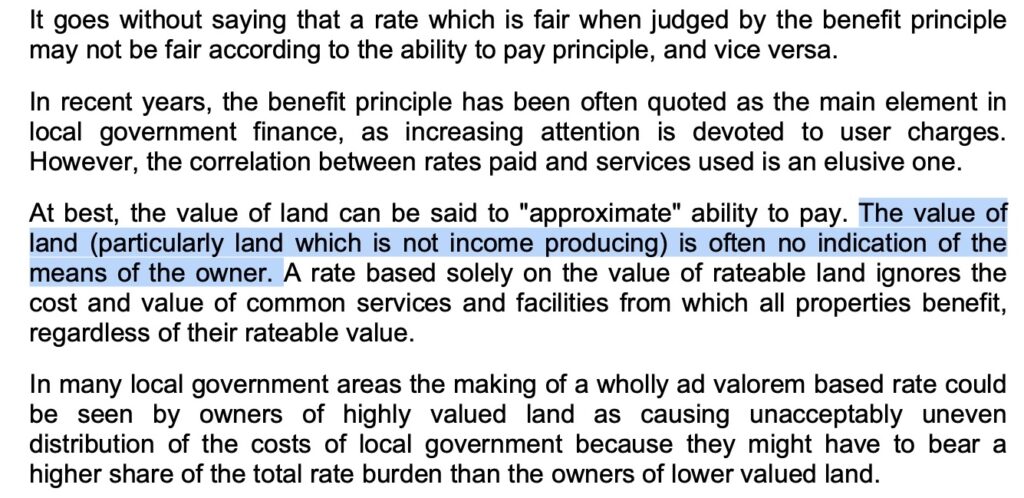
The new Council elected in December 2021 resolved in January to model changing the 'Base Rate' back to 50%. That's a move that I support. Those figures will be on public exhibition soon and the budget will be adopted to take effect July 1.
The common criticism is that people on acreage properties are rich and can easily afford higher residential rates, but the data reveals a different story.
The Hawkesbury Social Atlas displays a range of statistics about our area, including median weekly income broken down by suburb:
One analysis could be to compare median household income to median rates within the same suburbs to get a sense of fairness.

Weekly income and annual rates are figures with roughly the same magnitude (say $1000-$3000). It's not as though a ratio of one is a magic number – it's arbitrary, but it does allow for a comparison that factors in both rates and the 'ability to pay' principle.
Caveats: Such an analysis is just a guide – comparing the median-this to the median-that doesn't account for those that lay on the outer edges of those bell-curves. I know pensioners on below-median income sitting on land that just happens to be close to development that they loath and want no part of. Go and talk to them about what it's like to be taxed off the farmland that they and their parents grew up on.
Nor does this analysis touch on the other factor mentioned earlier – the relative access to services. Many residents of outlying suburbs live on dirt roads, and are far from the centralised services they are subsidising with their rates, while enduring other disadvantages. Setting rates with blunt tools isn't a science, as much as I wished were otherwise.
But this at least attempts to address the equity issue that is frequently raised by my colleagues in the chamber when they speak openly of 'rich acreage landowners' vs 'poor suburbanites' in built-up suburbs.
Here is what that comparison looks like for some suburbs under the current base rate of 30%:
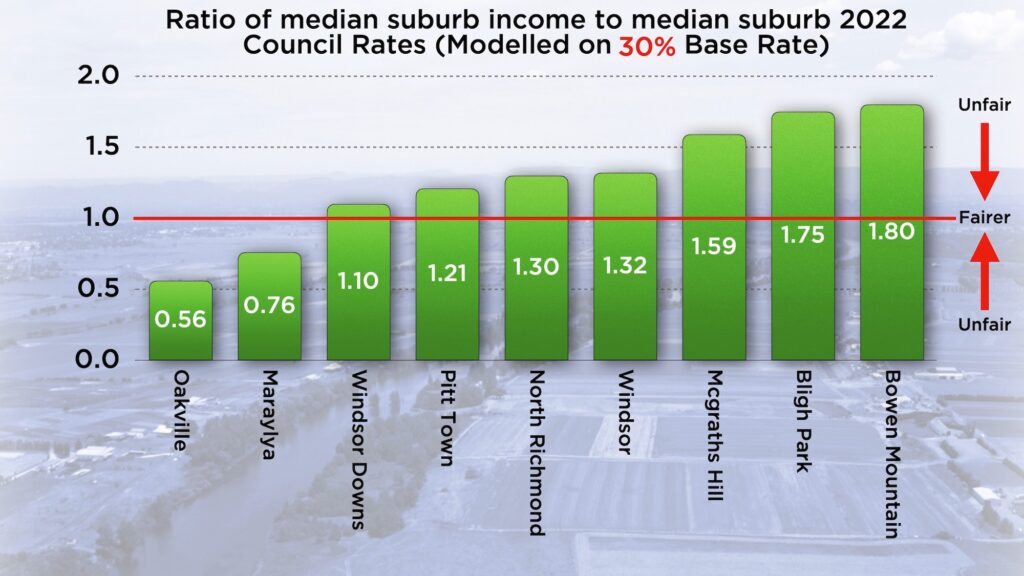
Here's what that means: Suburbs above a ratio of one are relatively advantaged, meaning that the rates they are charged are low compared to median household income in that suburb. Suburbs below the ratio of one are disadvantaged, meaning that rates are relatively expensive compared to income. In a fair system, one measure of fairness would be our ability to drive rates in suburbs towards the same ratio.
Now, here's what those ratios would look like for the same suburbs under a base rate of 50%:

Those suburbs who are paying not just double the average rates, but double even after factoring in relative income, move towards fairness. And other suburbs move in a modest way towards paying their fair share, and again, even after accounting for income.
If you want the raw figures, without adjustment for income, here is the preliminary modelling on a per-suburb basis for 2022-2023 rates in a range of Hawkesbury suburbs with a range of base-rates. These aren't final but will probably reflect figures which will be put on exhibition soon. Again, the base rate is 30% at the moment, and I'm advocating for it to move back to 50%.
A change to a 50% base rate is not a complete fix. It's cold comfort for residents in Oakville and Maraylya, enduring increased traffic from development and potholed roads being told that instead of paying well more than twice the rates as elsewhere, they'll now be paying only slightly more than twice even accounting for income.
Worse, the pensioner rebate on rates has been stuck at $250 for years and no longer keeps pace with our desire to give older people a hand, and Council has not addressed this in this year's budget. But any move towards fairness is a positive step.
Could we do more? Council can't set the base rate above 50% as that's limited by legislation. IPART released a long-delayed report into Council rating structures
Hawkesbury Council predicts it will take in $44M of rating income over 2022-2023 from 24,615 residences, 625 farms and 1617 businesses.
In 2016-17 that figure was $30.5M over 23,370 residences, 582 farms and 1509 businesses. In other words, Council revenue from rates have risen by 44% when the cumulative inflation rate over the same period was 11.6%
I’d say most Hawkesbury residents are prepared to pay rates that contribute to the common good, but their sense of a fair go is offended when they consider that some suburbs are paying two or three times the amount of rates of other suburbs with comparable income and access to services.
I'll continue to advocate for a fairer go while ever I remain on Council. If you don't already follow me on Facebook, Instagram or YouTube, please consider doing so for updates.
Saving Council money by trimming Councillor perks
At last night's meeting of Hawkesbury Council I presented a Notice of Motion to review our 'Provision of Facilities to Councillors' policy. The text of my motion is at this link.
When I was elected to Council in September 2016, I was surprised to be given a Windows laptop, a new iPhone with a SIM card, a printer, and a wireless modem & router to facilitate Internet access at home.
I didn't need or want most of these resources. I handed the laptop and iPhone back, and have never used the wireless modem router. Some of my fellow Councillors did the same. Representing the community is a privilege, and I was happy generally to use my own resources for Council business.
Frankly, the current policy is both wasteful and outdated. It refers to installing extra landlines and fax machines in Councillor's houses. It refers to arrangements for receiving a tape (an actual tape!) of Councillor meetings, even though we've been podcasting meetings for years.
I felt that the least we should do is update this policy so that the new Council elected in a few months are asked first what resources they may need – hopefully in the expectation that this will save ratepayers some money.
The motion was passed unanimously, which was very pleasing.
A new policy will be drafted and placed on exhibition for adoption before the elections in September.
Proposed McGraths Hill motel development knockback prompts litigation
Those driving down Windsor Road from Windsor will be familiar with the former but beloved Millers Nursery (a.k.a Windsor Garden Centre) on the left hand side on the corner of McGrath Road at McGraths Hill.

Opened by Ross and Lynette Miller in 1969, and carried on by daughter Bec it was a stalwart local business for 47 years. I remember it as a cosy and personal ramble – a place with nooks, and curios, and proper service. Not at all like the bland 'big box' nurseries that prevail now. Ross was active in Windsor Rotary for many years. Sadly, the business closed and the property sold in July 2016. The site has lain empty and sad ever since.
I mention this today because the fate of this site reveals in microcosm two things: The first is how Hawkesbury Council still has a long way to go to be a responsive, efficient public body that meets deadlines and applies our planning codes consistently. The second is how planning laws imposed by the State Government have disconnected the community from knowing much about, or having much say in Development Applications.
In 2017, the NSW Government instituted Planning Panels to determine DA's, removing the decision-making powers of elected Councils across Sydney. Planning Panels consist of unelected appointees who may have subject expertise in planning, but who are not democratically accountable to you, the citizen and voter. I and many other Councillors, including some Liberals were opposed to Planning Panels, and I've spoken at length about them before, including with 2GB's Ray Hadley.
A series of DA's have been lodged for the old nursery site to become a motel development. A pre-lodgement meeting held with Council in February 2018 indicated a desire to build a $10.8 Million, 130 bedroom motel.
DA0235/18 was lodged in May 2018 proposing a 94 room motel.
A decision on this proposal now sat with the Sydney West Planning Panel, with Hawkesbury Council staff writing a report with a recommendation for or against.
Council's report to the Planning Panel did not arrive until September 2019, over a year later. This kind of delay is itself an issue for me. Such determinations should not take so long. In October 2019 that application was knocked back, for a variety of reasons including the ability of the McGraths Hill sewerage treatment plant to cope with the load the development would place on it.
The applicants then came back with a new proposal for an 80 room motel under DA #0130/20, lodged on 13th May 2020.
I suspect not many people, even residents of McGraths Hill, knew much about any of these proposals.
76 days later, on 28/7/2020 the applicant made an application to the Land and Environment Court (case #2020/00226591) to litigate the DA on the basis of an assumed "deemed refusal", which means that the DA was not finalised or determined either way within the prescribed assessment period (which can be either 40 or 60 days).
Recently, on 31/5/2021 the application was withdrawn and a request for a refund of DA fees made, but only because this litigation was, and remains pending. A hearing may not occur until September.
In their letter withdrawing the DA, the applicants offered this stinging commentary to Council:
"It is with disappointment that we note that a lack of transparency from Council in relation to Council’s sewerage capacity issues and a lack of response from Council officers (who are too busy) in relation to the proposed on-site waste water system - which have prevented us assisting to achieve a satisfactory resolution of this development proposal."
I offer no commentary on the merits of the proposal, except to note that all applicants to Council are entitled to prompt and professional service within "best practice" assessment timeframes. If they didn't get it, I'd want to know why.
But my broader point is that, when decisions that shape the character of our neighbourhoods are taken away entirely from your elected Councillors and given to planning panels, the community ends up poorly informed (did you know about this?), and decisions are taken that you can't require anyone to be accountable for, and that's not good enough.
Oakville Oval needs an upgrade

Oakville Oval is one of 23 different playing fields, and one of the 215 parks and reserves around the Hawkesbury.
I've been a user of the oval all my life. I remember attending Oakville Public School sports carnivals there as a boy, kicking about kerosene-soaked fireballs when I was in Oakville Scouts (probably an OH&S nightmare now), and now witness my nephews play there as a soccer uncle.
Given the amount of use by the community, I feel Oakville Oval is looking a little tired and needs some care and investment.
Upkeep and development of our sporting fields is managed by the Hawkesbury Sports Council, who maintain two and five year plans for all local Ovals. In preparing those plans the Sports Council seeks submissions from sporting clubs and users of specific ovals. I was surprised to learn that, at the time the last plan was drawn up, no responses were received from the clubs that use Oakville Oval. I strongly encourage them to make a submission for the next round that will be called for the 2021/2022 financial year, and will be reaching out directly to make that appeal.
Council is aware of the increased use of the oval particularly during winter sports and the increases in parking and traffic. We've all seen the cars spilling on to the road, and the 'car park' is really just an abandoned gravel depot that turns to mud in poor weather.
The Sports Council advise that other suitable ovals in the area are used in conjunction with Oakville Oval wherever possible to spread the sporting community’s needs across the city.

I've always thought that using shipping containers to store equipment like rollers, goal posts and nets is ugly and less optimal than lock-up colourbond sheds on slabs with roller doors. However, I am informed shipping containers are considered a better alternative due to their sturdiness and they deter vandalism due to their locks and wall thickness. If you have a different view, please let me know.
Currently there is one shelter area at the Oval and some seating available around the canteen building. Due to the high level of use for various sports there isn't much room to install further shade areas without impacting on the current uses. There is also damage from the shade trees occurring to the on-field area in front of the containers as this area gets no sun. I am told that planting of additional trees might only compound this problem.
Hawkesbury Sports Council have planned to upgrade the irrigation system this year due to the field having to be returfed each year due to increasing use by the soccer club. Following the recent floods and damage to other grounds, the Sports Council has voted to place on hold all capital works until such time as the financial effects of the flood is clearer.
The Sports Council assigns its works program across all sports grounds and prioritises these as required. Where grant or other funding opportunities become available Council and the Sports Council will seek funding for upgrades, including the car park area. In addition, Council is currently planning for the development of Fernadell Park in Pitt Town. This development is subject to funding however, once developed, it will provide additional fields that can be used by the local sporting clubs and reduce demand on Oakville Oval.
Council will ultimately prepare a full masterplan for this and other reserves. I will be continuing to call for a long term plan, and sustained funding for improvements, on behalf of the residents and users who gain enjoyment and use of Oakville Oval.

A big win for Oakville residents

After nearly five years of banging on about the shocking state of our local roads, I was very pleased at Councils meeting of 30/3 to be able to negotiate additional funding to FINALLY SEAL Old Stock Route Road and Brennans Dam Road at Vineyard.
Most of this is new money, and was absolutely not on the table before.
Some additional commentary:
• Unfortunately this does not yet seal the Commercial Road approach.
• The culvert will have some drainage and scour works done, but will remain a single-lane crossing for now.
• I couldn't get the whole package of works through tonight, both because of our inability to complete the whole project within the deadline of the Commonwealth grant (31 Dec 2021), but also because I could not get more than this through the Chamber (for now).
• Further stages to fix Commercial + widen the culvert have been costed (~$450K) and I pledge to return to these ASAP.
• Yes, this road floods. Regularly. However, when natural disasters strike we get 100% coverage from the State Government to restore these roads but only on the basis of a 'no betterment clause', meaning we can't use disaster relief funds to improve a road beyond it's previous state. If however we improve it now, future damage will be covered to this new better standard. Some of the drainage works will help prevent road erosion against future flooding.
THANK YOU to my Hawkesbury Liberal Team Council colleagues and other Councillors who voted for this, especially those who reversed their previous opposition. Not everyone did...
Council Committees and protecting our Heritage

Hawkesbury City Council has no less than 17 different Committees.
They’re a mess – some have been around since Noah. Some have forgotten the reason for their creation. Some took it upon themselves to re-write their own terms of reference. Some are chaired by Councillors, some are not. Some take in members of the broader community as voting members, some not.
Some of the committees do good work, and enrich the decision making processes of Council. Some… not so much. Each committee requires staff resources to prepare agendas, minutes, and convene meetings.
A proposal was advanced at tonight’s Council meeting to restructure our committees for the first time in decades. It was a great idea – it streamlines the number and remit of committees, taking on detailed feedback received by a Council review over the last year.
It ensured that our committee meetings were public and open to public address (they aren’t now). That agendas are pre-published, and that documentation was available in a timely way to Councillors and the public alike.
It promotes the importance of existential threats like floods and bushfires to become the concern of the whole Chamber – not just a subcommittee.
I agreed. Many times I’ve been in a committee meeting and thought 'I wish all my colleagues were hearing this'.
I disagreed on one critical point – the proposal, as it was moved, sought to abolish our Heritage Committee.
Our Heritage Committee, which I’ve been a member of for four years, carries a disproportionate weight for Council. HCC doesn’t employ a full-time Heritage Officer. The members of this committee are a rare and special fraternity of heritage wisdom, including scientists, heritage architects, historians, and planning experts. We’re very fortunate to have them give their knowledge to us around the year, completely gratis. Put it this way – if we had to pay for their advice, we couldn’t afford it. The work this committee does fills a huge gap that would be impossible to fill if the committee was dissolved – and the motion before me sought to do just that. It sought to amalgamate its function into a committee with no community representatives and which shared billing with Waste and Environmental Sustainability – fairly poor bedfellows.
So, when the vote came, and despite my support for committee reform generally, I voted for a deferral so we could talk as a group of 12 about a better outcome that both permits reform, and protects our unique Heritage (and this committee). I expect the matter will come back to Council before Christmas.
Picture: Summer Noon, Hawkesbury River; Arthur Streeton, 1896.
Here are the remarks I made to Council when this came up:
New land valuations give little relief for rates in most Hawkesbury suburbs

Residents around the Hawkesbury should be receiving their latest land valuation letters from the Valuer General. I got mine this week.
I'll be making a more detailed analysis when some details crystallise, but since it's already been mentioned on social media, let me get some data out to you.
Every few years, the VG revalues your land. It has nothing to do with the improved value of your property (that is, with your house and other structures), but is used by Council to calculate your rates. This Council voted to turn the knob up on the formula which magnifies swings in land value on your rates. I and my fellow Liberal Councillors opposed that as unfair and this remains our view. I've made several videos and posts about this in the past, if you want a reminder.
For example, speculation caused by development near the NW growth sector caused land values in Oakville and Vineyard to soar in 2017, and the Council rubbed salt in the wound by applying for a staged 31% rate-hike (the SRV) which is still flowing through to you.
Here are three tables from Council's new 2020 analysis of the effect of the new valuation on rates, by suburb.
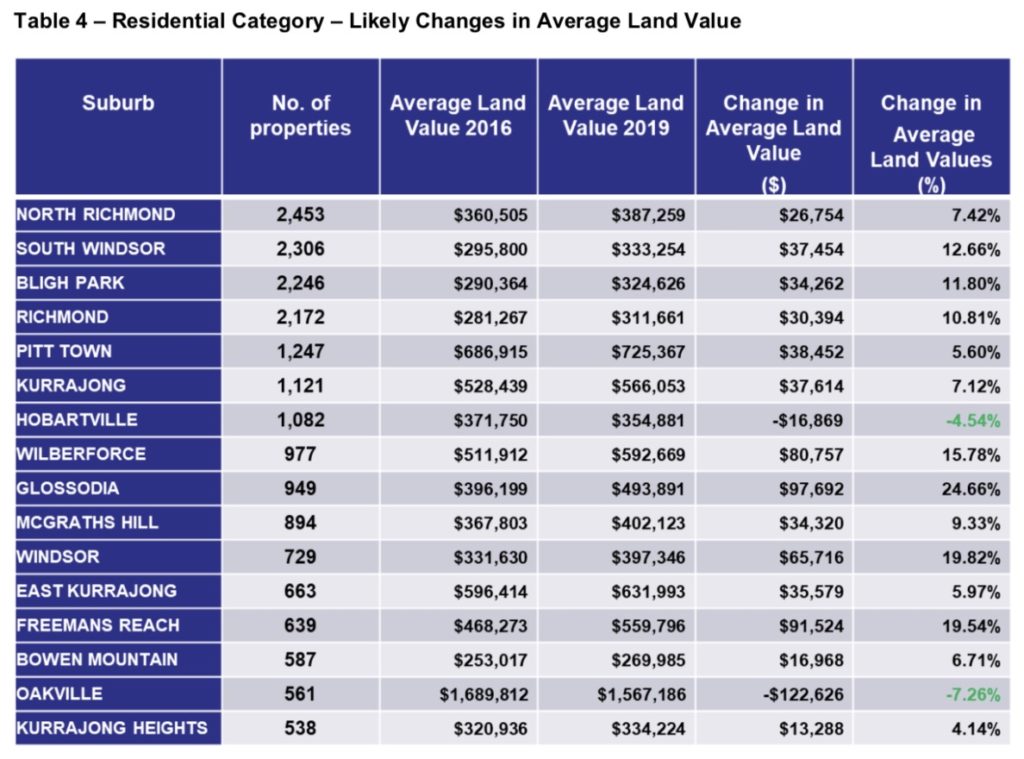
It shows that land values in Oakville have relaxed -7.26%, the biggest suburb drop in this round. However, given land values spiked 130% in the 2016 Valuation (206% in Vineyard, 66% in Maraylya, and 44% in McGraths Hill), this is little relief.
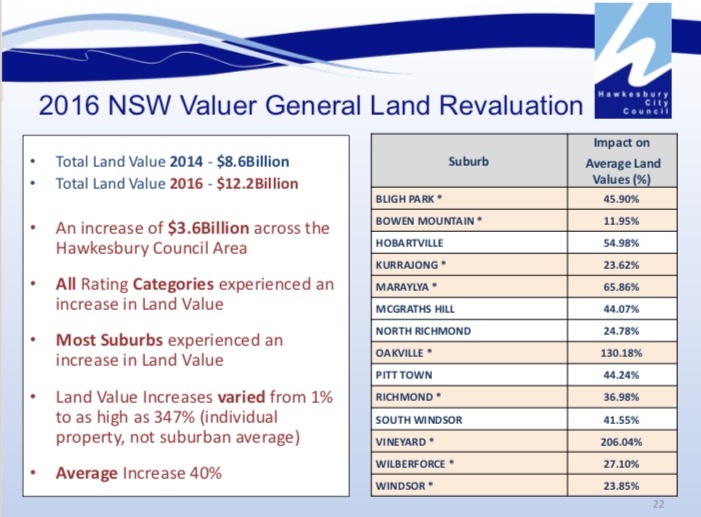
If this were the only factor, the average Residential rates in Oakville would drop $710p.a in the 2020-2021FY.

BUT, since the latest stage of the SRV is also going to be applied to your next rates bill, most of the gains are eroded.

So, the average rates in Oakville in 2020-21 will be $3598pa, down from $3905 this year, a saving of only $307.
These figures need to be taken with these caveats:
• Average figures are only that, and your own situation may differ.
• I've asked Council staff for more granular data including median rates, and I'm still waiting for them.
• These per-suburb figures are not final, as the VG has indicated some variations may occur in areas affected by the fires. This will affect the balance between suburbs and therefore the proportion each of us will pay.
Some people's rates in Oakville and elsewhere doubled (or worse) in 2017, and this new land valuation will give you very little relief. You're right to be angry. The current Council delivered a quadruple-whammy to you by abolishing the Rural-Residential category, increasing land value as an input to the rating formula, spiking everyone's rates by 31%, all at a time of rampant land value property speculation, which appears to be continuing.
I will continue to advocate for a fairer system.
On the plan to build a new Fire Control Headquarters in the Hawkesbury
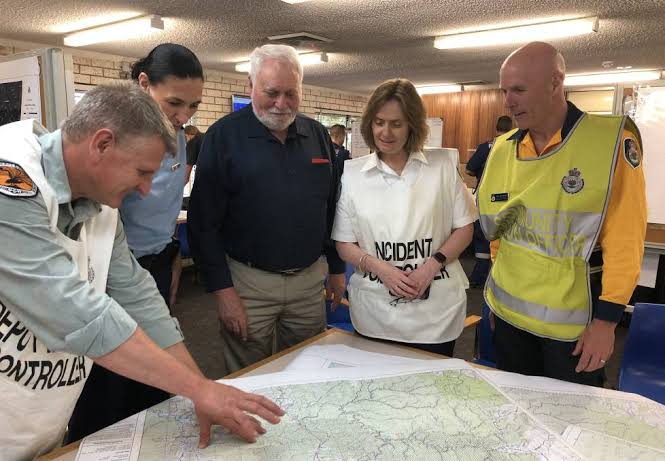
Recently at our last Council meeting for 2019, Hawkesbury Mayor Barry Calvert moved a Mayoral Minute to seize on the high profile of bushfires in the Hawkesbury.
In it, he advocated for Hawkesbury to build a new purpose-built Fire Control Headquarters, to replace the current facility at Wilberforce.
I know Fire Control well, having volunteered there for some years in my teens and twenties, under the then Fire Control Officer, Bill Rodger. Situated in the old Colo Shire Council chambers building, it was an ageing, awkward and pokey fit even a quarter century ago. Colo Shire Council was founded in 1906 and amalgamated into the Hawkesbury Shire Council in 1981.
At times of emergency, the place just isn't big enough. Temporary structures have to be built outside, necessitating much to-and-fro.
The Mayor's Minute was endorsed, unanimously. However, the way in which it was presented strikes me as worth further comment.
I think most people supporting such a move appreciate the sentiment behind it first, but then expect it to outlay concrete steps that lead to the desired outcome. A new, purpose built facility is a massive expenditure. Ground was broken in September for a new facility on the South West Slopes and that will cost $6.3 Million.
The Mayor's motion contained no financial commitment to either build, or even scope the ideal location and configuration of a new Fire Control Centre -- both pre-requisite in my opinion to the State government signing on for funding.
In other words, Council needs to budget money to build our case. There's little point in "initiating discussions" (as the motion says) to ask for such a significant financial commitment. Wilberforce may not even be the best location for a new facility -- some addressing the meeting nominated a number of alternatives.
This kind of wishlisting, without appreciating proper process or budgetary considerations, has happened before. As if smelling the wind, one Councillor added a clause to the motion to insist that the Wilberforce Brigade (who are co-located with Fire Control) be "fast tracked" to a new facility "within twelve months". In my opinion, this offers false hope, when Council's budget for the year has been locked in.
Michael Scholz, Captain of the Wilberforce Rural Fire Brigade addressed us and described the inadequacy of the current facility. No one disagreed. But the process of building a new fire shed involves forward planning and budgeting, and a lot of consultation. It can't be done by fiat on the spur of the moment. Two fire shed renovations in the Hawkesbury were held up for several years by spurious Native Title claims.
Our RFS locally have and continue to do a heroic job. There's definitely a case for a new Fire Control Centre. However, we have to now take concrete action: to budget, to scope our plan, to make a compelling case, and to commit to co-funding the facility. In my opinion, only then will our State Government take us seriously.
Pitt Town Road upgrades
Back in August 2017 I joined members of the Pitt Town Progress Association, fellow Councillors and staff on a tour of the Pitt Town area to identify a long list of "action items". High on that list were upgrades to Pitt Town Road that were promised as benefits to the Pitt Town development.
These upgrades consist of the Pitt Town Bypass project, which received a $4.7M boost in the most recent State Budget (and which will be an estimated $8.2M for the whole project), and upgrades to other intersections between Pitt Town and McGraths Hill. I hope the Bypass will have shovels in the ground in 2020.
The most important of these other works is the intersection of Pitt Town Road and Saunders Road. Increasing traffic has rendered this intersection dangerous for some time. I know people personally who have had serious accidents there.
It is pleasing to see these works now underway, but many have asked me why it looks so elaborate, and what all the pipes sticking out of the ground are. I am advised that the pipes mark the location of various underground services such as water and gas.
There will now be dedicated turning lanes when coming along Pitt Town Road, in both directions, for traffic turning into Saunders Road, and for traffic turning into Pitt Town Bottoms Road (towards Lynwood).
Here is a one-page graphic of the works proposed, and below that is a more detailed PDF copy of the plans.

We don't need another referendum about Council

At the last Council election we also held a referendum on whether our city should be divided into wards. That exercise – really just the thought bubble of one Councillor -- cost us $24,000 and the idea went on to be soundly rejected by the community.
At our Council meeting tonight we were asked to consider if there was any other change we wanted to put to a referendum for the local government elections that are scheduled for September next year. Would we like 13 Councillors instead of 12? A popularly elected Mayor? To revisit the Wards issue?
I took the view that these suggestions wouldn’t improve the quality of democracy in our city.
Some of our Councillors made a very conspicuous show only a couple of months ago of rejecting a CPI-rise in the fee paid to Councillors -- a virtue-signalling exercise that would save Council a grand total of $7,132p.a. Nevertheless, tonight the same ones took a shine to the idea of holding another referendum that would cost another $24K (or more) to put to voters, and in the case of increasing Councillor numbers, another $80K+ in pay across the 4 years of a Council term.
I confess, I found that a trifle inconsistent.
So I voted for the status quo. I’m happy to report I was in the majority. I suggest that the money we save by not entertaining thought bubbles like this will be better spent on better roads, parks and services.
Hawkesbury landowners get extended deadline for review of their land value
"In this episode, a climactic meeting with the Valuer General, plans to secede from the Hawkesbury, and a ray of hope for people who have endured massive rate rises, but only if you act now.
In my last video I described how thousands of Hawkesbury ratepayers have been hit with a big rise in their Council rates. I described how the 23% of our landowners whose rates have gone up, are now paying 35% of Council rates, and how that just isn’t fair.
I explained how the biggest part of that rise came from changes to land value as calculated by the Valuer General. An important development has occurred recently that you need to know about.
Hosted by Council, a representative from the Valuer General’s office came to a very well attended meeting at the Windsor Function Centre on August 30th.
Present were hundreds of angry ratepayers, stung by the rise in their rates, and who generally had not availed themselves of the opportunity to apply for a review of their excessive land valuation before the 60 day cutoff – the period that began after everyone received their valuations earlier this year.
At that meeting, the Valuer General made two concessions. The first is that Hawkesbury Residents have now had the deadline extended, and they can apply for a review of their land valuations until the end of September 2017.
If you live in the Hawkesbury and your rates have gone up, I strongly suggest that you apply to ask for a review of your land valuation.
The details of how to do that are at the link on the Valuer General’s website. My hope is that if enough people do this, some pressure can be brought to bear.
The second concession was that no landowner asking for a review in this round will have their land valuation put up. This is important because when you ask for a review, it could go down or up, and this makes the process of asking for a review a no-risk proposition.
However, unless you cite the right reasons, your application for a review may fail.
“I don’t like this” or “I’m on fixed income and can’t afford to pay” aren’t likely to get much traction, even if they’re true.
As I see it, there are three grounds for review, especially if you live in the Oakville, Maraylya, or Vineyard area.
The first is that real-estate values are being distorted by adjacent development caused by the North West Growth Sector.
Of course, one riposte may be that, even so, they are current the real-estate sales values, and that the Valuer General’s is merely applying their formula, and that’s that.
However, residents attending the meeting at Windsor were alarmed to find that only around ten sales in the area were used to define the values for the whole suburb, which is over 1200 properties in Oakville, Maraylya and Vineyard. This sample space is too small to be representative. Similar properties are grouped together into statistical units called Components. Nearby components separate to the Oakville component are cheaper, despite both containing acreage properties with similar aspects and uses. In my opinion, the Valuer General’s methodology is flawed.
My second concern is that land value should be reflective of what people can do with it. This instructive video from the Valuer General acknowledges that things like whether the land is sloped, or has an ocean view, has good soil, or is subdividable, all affect land value. Overwhelmingly, your land that has risen in value so sharply can only be put to the same use that it could be put a year ago, and no subdivision is in prospect. The Valuation of Land Act states that land must be valued according to its “highest and best permitted use”. But what happens when land is bought, at inflated prices, on the basis of speculation that it will be rezoned in the future for a different purpose?
The Valuer General should be prudent enough to mitigate against the effects of speculation in the market.
The third concern is that the Valuer General should acknowledge that changes as severe and rapid as this are socially and politically intolerable.
When you think about it, there is some precedent here. Look at what happened with the recent Fire and Emergency Services Levy.

You will recall this was introduced with great fanfare by the State Government in December 2015, only to be withdrawn in July this year, precisely because the government’s modelling was flawed. When it came out that the change in tax to many property-owners, based on land valuations from the Valuer General, were too steep, too unfair and too rapid, the whole program was put on hold.
Political intervention was justified there, and is here too, and for exactly the same reasons.
Your Liberal Councillors, including myself, have stood up for Hawkesbury residents on two fronts. To the degree that Council can affect change, we will continue to push for it, all the while continuing to bring these concerns before our State colleagues as well.
I’ll end by answering a remark I’ve heard at more than one community meeting. Ill-feeling is bad enough among some to suggest that parts of the Hawkesbury feeling this financial pain should secede from the Hawkesbury and apply to join the Hills Shire, or that the whole question of amalgamation between the Hawkesbury and the Hills be re-opened.
I’m not sure what you’d call that. Following the model of Brexit, should it be Hawkes-xit? Oaks-xit?
Frankly this is a nutty idea. Firstly, Hills Shire council never saw a development they didn’t like, and if you want the whole of the Hawkesbury to look like Rouse hill or Kellyville, then… please see your GP to change your medication.
Secondly, you would be no better off. The Hill’s rating structure is not so different to our own. To join the Hills Shire, where people may or may not eat their babies, would be at best a Faustian bargain that we would regret.
The Hawkesbury is a special place, and it deserves to stand on its own and determine its own destiny. I regard our corner of the world as a bulwark against the encroachment of what I call ant-hill Sydney. It is a valuable region of the greater Sydney area that is still most valuable for its amenity, open space, agriculture and heritage. If people can’t afford to live on acreage allotments because the rating structure is unfair, those on Council who have engineered this change might care to accept some of the blame when landowner’s thoughts turn to selling up to developers.
Video blog - Hawkesbury Council rate rises and the Valuer General
Further to an earlier post on Hawkesbury Council's rates rises, I've done some further analysis on the factors contributing to sharp rate rises for many Hawkesbury ratepayers, especially those in Oakville, Maraylya and Vineyard.
The maps referenced in the above video can also be downloaded here.

Remember, subscribe, like and share for updates!
Are some Hawkesbury residents paying too much tax?

The hot-button issue this month is that rate notices arriving in the letterboxes of many Hawkesbury ratepayers show that their rates have risen sharply, while other suburbs have had a modest decrease. And by "risen sharply", I mean doubled or tripled from this time last year. The worst example I found was a property at Pitt Town now paying over six times the rate of an average property compared to last year.
Most residents accept that paying tax (in this case, Council rates) is necessary to provide the services people expect. However, many community consultation meetings (and last Tuesday's Council meeting) were full of ratepayers who are visibly angry at what they feel is a betrayal of the principle everyone pitching in equally; the Aussie notion of a "fair go".
So are some people now bearing a disproportionate burden of Council rates? I and my fellow Liberal Councillors think some are, and we've tried to do something about it.
What's happened is a triple-whammy of changes and proposed changes, and it's been challenging to educate the public about the contribution of each part.
Here's how to understand what's happened.
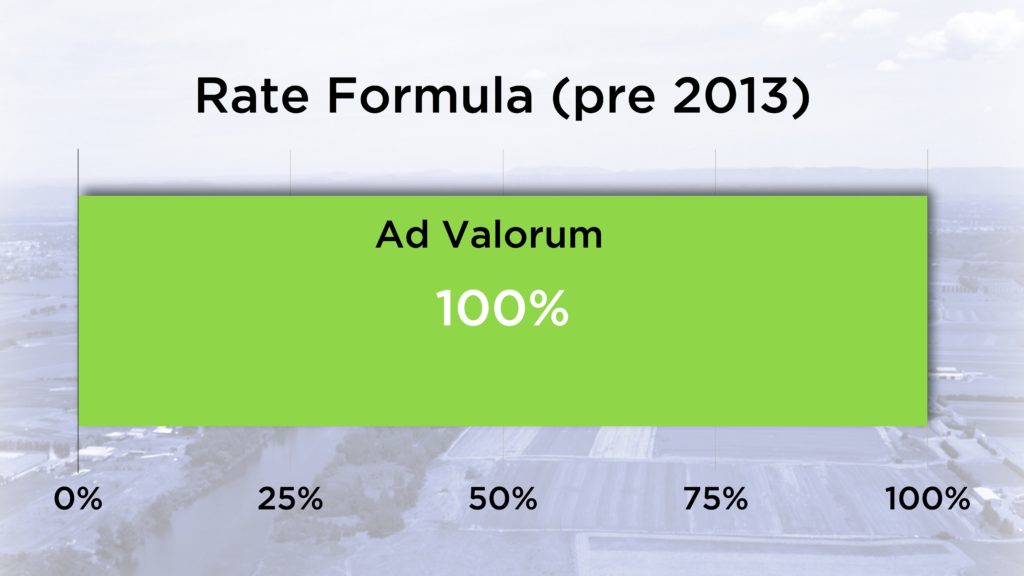
Prior to 2013, your Council rates were calculated entirely on your land value. This is called the "Ad Valorum" approach (Latin for "according to the value"). This of course meant that if your land value rose sharply, your rates reflected that rise very directly.
The Liberal-lead Council instituted a change in 2013 that introduced what's called a "Base Rate" of 50%, meaning that there was a standard charge paid by everyone, and that the remainder of rates Council collected based on land value was also 50%.

The Liberal Council regarded that as a reasonable and democratic change to make, and it resulted in an "evening out" of rates paid by both residential and rural-residential landowners. Rural-residential properties frequently are situated further from common resources in the towns, and endure worse roads, a lack of kerb and guttering, poorer street-lighting, and other disadvantages. Of course, the 2013 change resulted in some rates rising and some falling, but the changes were calculated to be moderate, and not extreme, unlike the most recent changes.
In September 2016, a majority of the Councillors elected to Hawkesbury Council were Independents, Labor and Green. The four Liberal Councillors are now outvoted by the 8 Councillors in this decidedly left-wing alliance.
This year, the new Council decided to change the formula again and reduce the base rate to 30%, and consideration is being given to a Special Rate Variation (SRV) that will put everyone's rates up by more-than-rate-pegging if the proposals currently before us are endorsed by the Council and then by IPART.
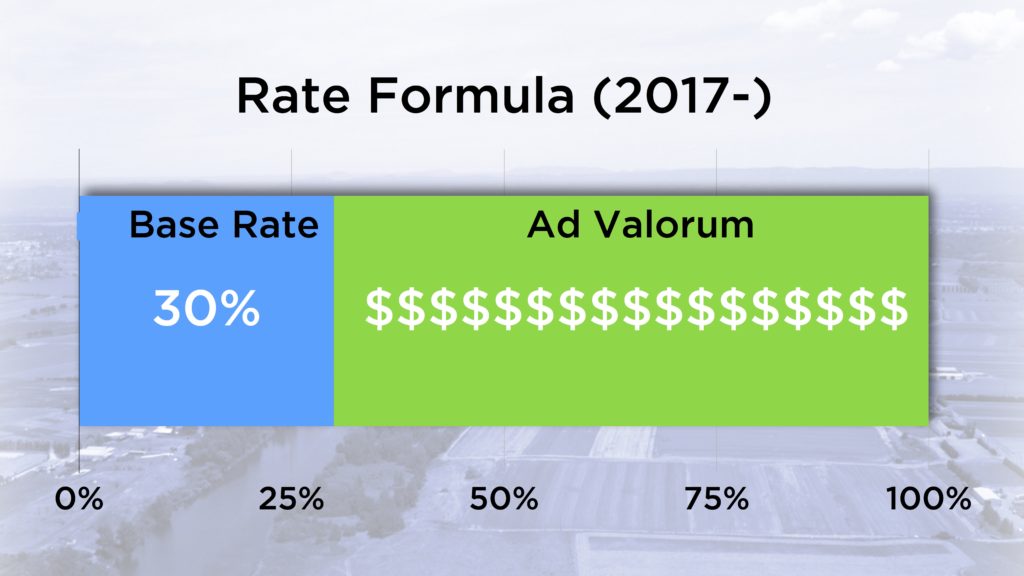
Your Liberal Councillors voted against this change. The reduction of the Base Rate to only 30% means that people experiencing a spike in land value are more heavily hit.
It is not the purpose of this article to argue the case for or against the SRV, as that is more complicated.
Enter, the Valuer General. Land values in a range of suburbs across the district have changed sharply in the most recent round of valuations (which generally occur once every four years).
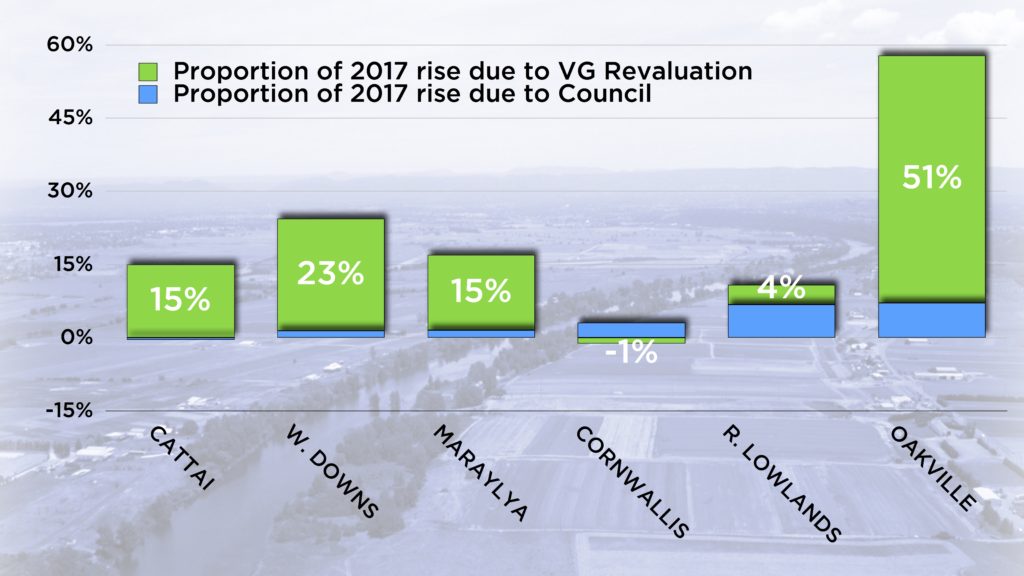
The area in which I live, in Oakville, has been particularly hard hit, with the average rate rise of 57%, and with some property owners very much harder hit than that.
Frankly, the Valuer General has erred in valuing the land in Oakville in the way that it has. It has erred because land value should reflect the prospective "subdividability" (if I might coin a word) of land, and of course there is no prospect of landowners in Oakville being able to subdivide their land at all in the near future. The land valuations are calculated on recent real-estate sales figures, and this isn't the same thing. Very heavy development is occurring on the other side of Boundary Road in the Hills LGA, and this has artificially skewed the figures in a highly disadvantageous way to Hawkesbury residents whose income has not risen magically to keep pace with their land value. I am heartened to hear that the Valuer General will be visiting the Hawkesbury to meet with residents and my hope is that they will be willing to revisit their valuation processes instead of simply coming with the attitude of only explaining but not changing their conclusions.
At the Council meeting on Tuesday 8th August, the gallery was packed with residents supporting a Liberal resolution to re-visit the rating formula and to apply pressure to the Valuer General to explain their decision. This motion was opposed by Mayor Lyons-Buckett and the independent-Labor-Green alliance and substituted with a significantly watered down motion that effectively called for no action to be taken on the base rate.
This was disappointing, and rural-residential landowners badly affected by both the change in formula and the Valuer General's decision will continue to be hardest hit.
I and your Liberal Council representatives will continue to listen and represent your concerns, right up to the next Council elections.
-Councillor Zamprogno.
Bilpin businesses need help from Council, not fines

Sean Prendergast, founder of Bilpin Cider, is on the phone with me, and he's livid.
"$6000! Council fined me $6000 for having a sign on a trailer outside my business!"
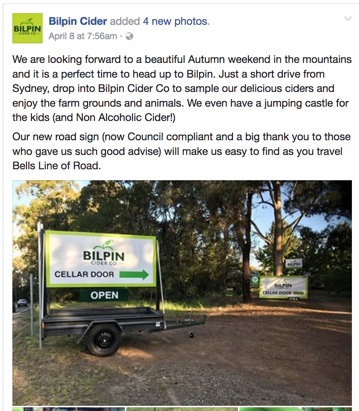
My ancestors were orchardists for over a century, at Glenhaven, and so I'm immediately sympathetic.
What's worse, he tells me, is that in previous interactions with Council, he had formed the view that his current signage was compliant, after an earlier shot across the bow relating to "approach signage", meaning signage placed along Bells Line of Road to let drivers know about approaching businesses and giving them the opportunity to slow down.
As it happens, I had already been speaking to Wayne Tapping, of Wildwood Gardens, His situation is worse, as his venue and café is on Powells Rd, just off Bells Line. "Without signage on the corner to let people know where we are, our business drops by more than half" says Wayne.
And what did Council do with his A-frame signs? They impounded them at Wilberforce, and told him that if he picked them up before 5pm, they would waive the $213-per-sign fine.
Knowing this, the story that appeared in the Gazette two days ago, Orchardists Reel as signs prohibited - rules cruel Bilpin orchards and food outlets, is entirely unsurprising, and something needs to be done about it.
The problem is that the rules governing signage in our city are too inflexible. No one wants ugly signage in our already built-up areas, and the rules are there for good reasons. That said, some strange things still slip through. The Windsor Holden building in Macquarie St Windsor is a monstrosity, but I shall move on...
But businesses in Bilpin need every support they can get from Council, not $6000 fines. Under the current rules, they aren't even permitted A-Frames (which require a form to be lodged and a $119 fee), because such signs are limited to business and industrial zones. The farm sheds most orchardists sell from are not considered business areas and are zoned "Rural". Even signs on their own properties can't be bigger than 0.75m², and higher than 2.5m above the ground. Good luck seeing that, barrelling along Bells Line at over 80km/h. Worse, our current LEP doesn't permit approach signage at all. I'm sympathetic to the argument that approach signage improves road safety by giving potential customers time to make a choice, slow down, and look for the business coming up. So it's clear that rules that work well in other places, are not working well in Bilpin.
Council's current response is to suggest that Bilpin business make better use of Social media. This is more than a little dismissive, and it isn't good enough. As the Gazette article points out, the number of orchardists in Bilpin has dropped from over eighty in the 1980s to ten today, and all of them rely on direct sales to some degree. The orchards in Bilpin are a key part of the agricultural, social and tourist fabric of the Hawkesbury. We shouldn't let them die.
When asked by the Gazette, Council says that "If business operators request that Council look into a signage policy, then Council can look into developing a signage policy for businesses around Bilpin area to provide more guidance. Until such times the current policies remain in force."
I think we need to go beyond this. I want Council to take the initiative and develop a signage policy for Bilpin that balances the needs of those local businesses, draws the tourist trade, and yet is mindful of road safety and the aesthetic of our rural landscapes. Compliance to local ordinances and planning rules is important, but Bilpin businesspeople need our help. People like Neville Julian, and Shelley Julian, and Sam Ramaci, and Sean Prendergast, and Wayne Tapping, and many others would be entitled to think that, on current form, they aren't getting it.
I have reached out to my Councillor colleagues on this matter and so far I have received a very positive response. Stay tuned.
Is the Hawkesbury a Shire or are we a City?
I still remember that when I was a kid in 1989, "Hawkesbury Shire Council" changed its name to "Hawkesbury City Council".
I wondered then, as I do now, why we bothered. It seemed a pointless gesture which worked actively against the identity most locals held about the area. I believe it sprang from an erroneous sense of inadequacy, and that we lost nothing by continuing to be known as a Shire.
Did you know the word Shire is a Saxon word, whereas County is its Norman equivalent? And a city, as our late Mayor Rex Stubbs used to explain to me, was a "town large enough to have its main church called a cathedral". Despite Rex's romantic penchant for referring to our historic St Matthew's church (this year celebrating its bicentenary!) as the "Cathedral of the Hawkesbury", I'm afraid I just don't buy it. We don't have to be a city. Let's look at some numbers.

There are (subject to the ongoing vagaries of the Council amalgamation process), presently 128 Councils in NSW. The City of Hawkesbury has a population of 66,134 (per 2015 ABS Statistics). It's just a fact that plenty of Councils bigger than us are perfectly happy to continue to be known as "Shires", even when given recent opportunities to re-name. Look at Hornsby Shire (population: 156,847), Hills Shire Council (169,872), or Sutherland Shire (210,863). The latter is three times our size, and they feel no need to "upgrade". And no-one could accuse our near neighbour in The Hills Shire for being less dynamic or future-oriented. Further, their adherence to the word Shire is not an anachronism, considering they had the opportunity to re-brand themselves as a "city" when they changed from "Baulkham Hills Shire Council" (a name in use since 1906) to "The Hills Shire Council" in November 2008. And look at that area now!
I've always held the belief that the word "Shire" was more pleasant than "City", both for its ancient linguistic roots, but also its evocation of bucolic, open spaces.
The term Shire, in our case, used to reflect the fact that we were precisely not a bustling, congested, urbanised polis. We lay... between. We were between Sydney city proper and the country. The trendy term now in use is "peri-urban", but I find this to be a little pretentious. One could speculate that Tolkien would never have used such a Newspeak word when trying to evoke his sylvan idyll. The recent process I engaged in to draft our new Community Strategic Plan underlined that what we aspire to as our identity is largely defined by our semi-rural aspect. Our mix of habitation, agriculture, and protected environmental spaces is well described with the word "Shire". The word "City" just seems to convey the opposite to me, and, considering our population and neighbours who don't use the word, makes us look more than a little self-conscious.
Should the Hawkesbury remain as a City, or go back to our old name of "Hawkesbury Shire"? I think we should, even while I acknowledge that there is probably little appetite for the change. Further, there would be the cost of changing all our signage, letterheads and other livery -- and I would absolutely oppose that needless expense while we have more important matters to attend to as we pursue long term financial sustainability as a Council.
What do you think? I'm interested in knowing.
Here's a timeline of the naming of our municipality:






